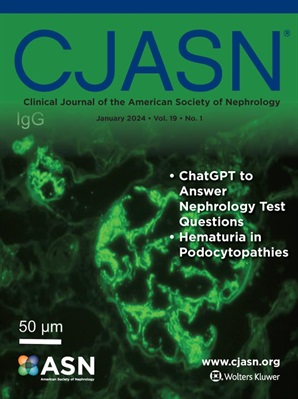GLP-1 Receptor Agonist Outcomes, Safety, and BMI Change in a National Cohort of Dialysis Patients.
IF 8.5
1区 医学
Q1 UROLOGY & NEPHROLOGY
Clinical Journal of the American Society of Nephrology
Pub Date : 2025-06-17
DOI:10.2215/cjn.0000000750
引用次数: 0
Abstract
BACKGROUND Of the 808,000 US dialysis patients, 60% have diabetes and are eligible for glucagon-like peptide-1 (GLP-1) receptor agonists. Safety and outcomes in this population is unknown. We sought to examine GLP-1 receptor agonist real-world safety, efficacy, and weight loss in people with diabetes on dialysis. METHODS In this observational national cohort study (2013-2021), we identified adults with type 2 diabetes on dialysis. The exposure of interest was GLP-1 receptor agonist use. Body mass index (BMI) change after dialysis initiation was quantified among patients with two measurements (N=6,474). Extended Cox models with inverse probability of treatment weights (censoring for kidney transplant waitlisting) were used to quantify all-cause mortality associated with GLP-1 receptor agonists. Specific safety outcomes (acute pancreatitis, biliary complications, medullary thyroid cancer, diabetic retinopathy) were assessed. RESULTS The study included 151,649 incident dialysis patients with type 2 diabetes. Mean BMI and weight change among GLP-1 receptor agonist users were greater than that among non-users (-1.47 versus -0.61 kg/m2; -4.03 versus -1.47 kg; P<0.001 for both). The mortality incidence rate was lower among GLP-1 receptor agonist users (219.0 versus 279.5 cases/1,000 person-years; P<0.001). GLP-1 receptor agonist use was associated with a 23% lower risk of mortality (adjusted hazard ratio [aHR]: 0.77, 95% confidence interval [CI]:0.70-0.85; P<0.001); results were consistent among initiates with BMI≥30 kg/m2. GLP-1 receptor agonist use was associated with a 66% higher chance of waitlisting (aHR=1.66, 95%CI:1.28-2.13; P<0.001). There was an increased association with diabetic retinopathy (aHR=1.32, 95%CI:1.12-1.56; P=0.001), but not with any other safety outcomes. Inferences were consistent across multiple sensitivity analyses. CONCLUSIONS GLP-1 receptor agonist use in patients with type 2 diabetes on dialysis was associated with weight loss, reduced mortality risk, and increased likelihood of kidney transplant waitlisting. These real-world data are the strongest evidence to date supporting GLP-1 receptor agonist use in this population.GLP-1受体激动剂在全国透析患者队列中的结局、安全性和BMI变化。
背景:在美国80.8万名透析患者中,60%患有糖尿病,适合使用胰高血糖素样肽-1 (GLP-1)受体激动剂。该人群的安全性和结果尚不清楚。我们试图检验GLP-1受体激动剂在糖尿病透析患者中的安全性、有效性和体重减轻。方法:在这项观察性国家队列研究(2013-2021)中,我们确定了接受透析治疗的成人2型糖尿病患者。暴露感兴趣的是GLP-1受体激动剂的使用。采用两种测量方法(N=6,474)对透析开始后的身体质量指数(BMI)变化进行量化。采用治疗权重逆概率的扩展Cox模型(筛选肾移植等候名单)来量化与GLP-1受体激动剂相关的全因死亡率。评估了特定的安全性结果(急性胰腺炎、胆道并发症、甲状腺髓样癌、糖尿病视网膜病变)。结果本研究纳入151649例2型糖尿病透析患者。GLP-1受体激动剂服用者的平均BMI和体重变化大于非服用者(-1.47 vs -0.61 kg/m2;-4.03 vs -1.47 kg;P<0.001)。GLP-1受体激动剂服用者的死亡率较低(219.0 vs 279.5例/ 1000人年;P < 0.001)。GLP-1受体激动剂的使用与23%的死亡率降低相关(校正风险比[aHR]: 0.77, 95%可信区间[CI]:0.70-0.85;P < 0.001);BMI≥30 kg/m2的入行者结果一致。GLP-1受体激动剂的使用与等待登记的机会增加66%相关(aHR=1.66, 95%CI:1.28-2.13;P < 0.001)。与糖尿病视网膜病变的相关性增加(aHR=1.32, 95%CI:1.12-1.56;P=0.001),但与其他安全性结果无关。结论在多个敏感性分析中是一致的。结论:2型糖尿病透析患者使用sglp -1受体激动剂与体重减轻、死亡风险降低和肾移植等待排队的可能性增加有关。这些真实世界的数据是迄今为止支持GLP-1受体激动剂在这一人群中使用的最有力的证据。
本文章由计算机程序翻译,如有差异,请以英文原文为准。
求助全文
约1分钟内获得全文
求助全文
来源期刊
CiteScore
12.20
自引率
3.10%
发文量
514
审稿时长
3-6 weeks
期刊介绍:
The Clinical Journal of the American Society of Nephrology strives to establish itself as the foremost authority in communicating and influencing advances in clinical nephrology by (1) swiftly and effectively disseminating pivotal developments in clinical and translational research in nephrology, encompassing innovations in research methods and care delivery; (2) providing context for these advances in relation to future research directions and patient care; and (3) becoming a key voice on issues with potential implications for the clinical practice of nephrology, particularly within the United States. Original manuscript topics cover a range of areas, including Acid/Base and Electrolyte Disorders, Acute Kidney Injury and ICU Nephrology, Chronic Kidney Disease, Clinical Nephrology, Cystic Kidney Disease, Diabetes and the Kidney, Genetics, Geriatric and Palliative Nephrology, Glomerular and Tubulointerstitial Diseases, Hypertension, Maintenance Dialysis, Mineral Metabolism, Nephrolithiasis, and Transplantation.

 求助内容:
求助内容: 应助结果提醒方式:
应助结果提醒方式:


